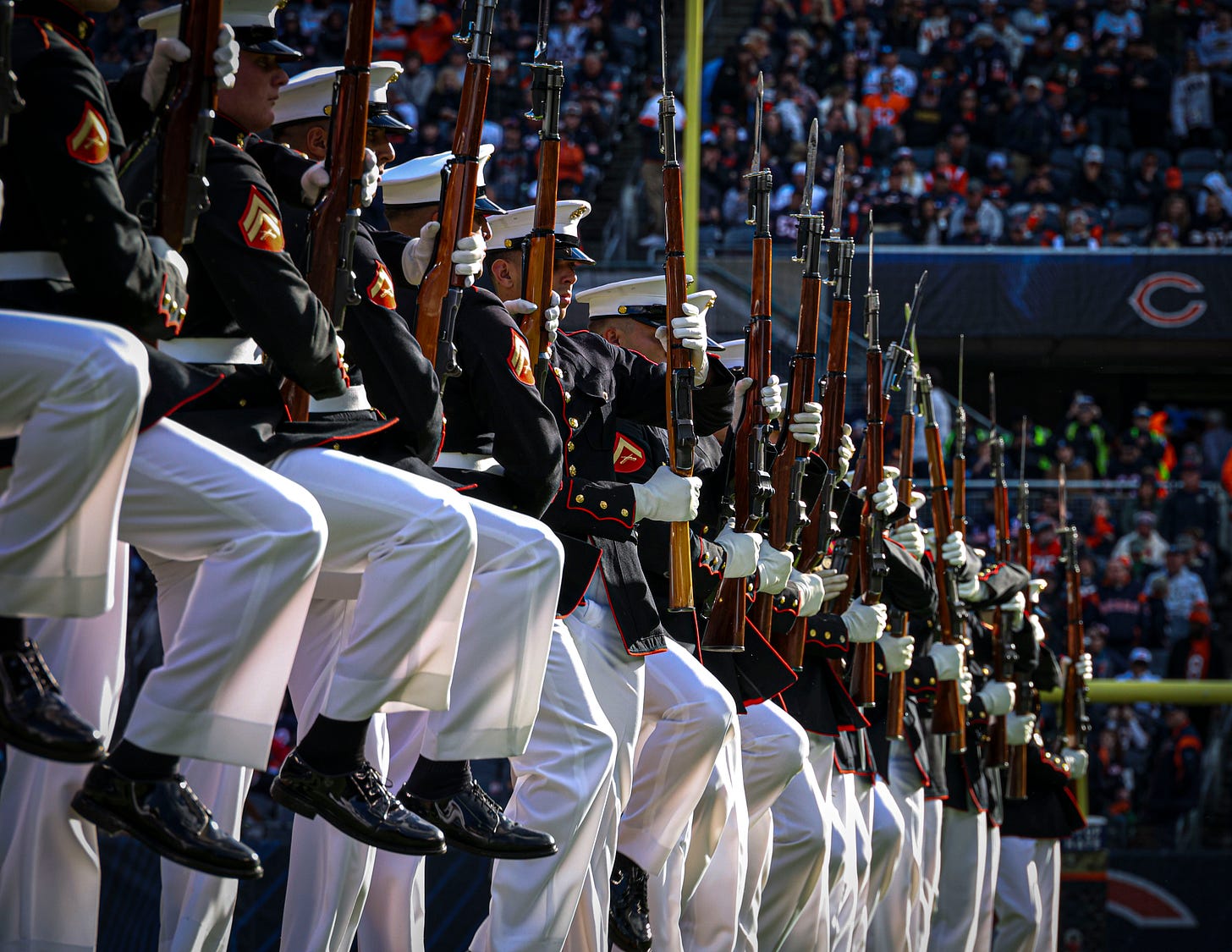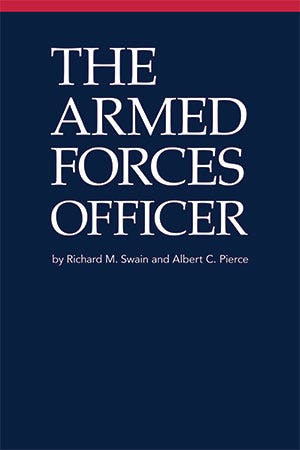Note: Much of what I’ve written thus far and shared with you here has focused on the intersection of social science, philosophy, and, to some extent, theology as they pertain to how we humans navigate the hardship and uncertainty of life. That will continue. Another important part of how we navigate a certain segment of life’s crucibles involves how we conceptualize, operate, and interact with the military. Why? Click here for an explanation. So, I’m exploring that once in a while via a ten-part series unpacking ideas from the book The Armed Forces Officer.
Below is part 2 of 10 (click here for all posts on this topic). As always, these are my views, and they do not necessarily represent the views of the U.S. Department of Defense or its components.
Introduction
A professional military in a civilized society is a unique entity. It is a group of people, who, by the authority granted them and using the training they receive, work on behalf of the state to engage in the professional “management of violence” as discussed in “The Profession of Arms,” the second chapter of The Armed Forces Officer.
Although military forces frequently engage in non-war activities—for example, humanitarian assistance and disaster relief—their raison d’être, the primary reason they exist, is to exert lethal force under conditions that may threaten the lives and limbs of their own members. Society and the state grant this special authority and responsibility to the military, which in civilized contexts also comes with the expectation that such application of force will be ordered in nature.
There is and should be a substantial difference between a roving band of armed citizens and a professional military unit; we expect the latter to not only be well-trained and equipped but also to uphold certain standards for when and how it applies its lethal force—standards to which it is held accountable by both itself and the state. Additionally, a professional military exists for the benefit of the larger community that it represents, not for its own benefit or for the enrichment of any of its members.

At the heart of the profession of arms is the idea that its members are selfless in their service of that which is greater than themselves: their nation, their unit, their friends, and comrades in arms. In that way—among others that I’ll summarize later—we can consider military service to be a profession.
As Richard Swain and Albert Pierce write in The Armed Forces Officer,
Like the priesthood, the profession of arms is a vocation, a higher calling, to serve others, to sacrifice self, to be about something larger than one’s own ambitions and desires, something grander than one’s own contributions and even one’s own life. This is a recurring and central theme in discourses on the profession of arms. (p.17)
Let it be known that I also see many differences between the priesthood and the profession of arms, but in terms of the notion of selfless service as a vocation, the comparison stands.
In addition to the clergy, most modern societies also recognize the fields of medicine and law as professions. There’s a whole body of social science research on professions, but suffice it to say that the military also appears to meet the general criteria for being a profession.
In particular, Swain and Pierce argue that a professional military, like other professions, has specialized expertise, a responsibility to serve society, a sense of what some have called “corporateness,” and a professional ethic and ethos. Below, I summarize each idea.
Expertise
A specialized body of knowledge, built through experience and study and communicated through education and training, is one characteristic of a profession. And it is one that permeates any modern professional military, giving it the ability to execute its duties in a way that maintains the confidence and trust of the nation.
In the U.S. military, such expertise develops first through initial training but then continues throughout one’s career. Speaking personally, I engaged in a wide variety of academic and practical training for four years prior to my commissioning as a Navy officer. Immediately after that, I spent several months in specialized training for my particular duties, training that then continued in an on-the-job fashion for several years.
In the more than two decades since then, I’ve participated in numerous training activities, from required annual training to practical exercises to various courses ranging from a few days to many months in duration. The expectation and reality of being in a professional military truly is one of lifelong learning.
Service to Society
The profession of arms exists in a contract of sorts with broader society. As Swain and Pierce put it,
A profession has a responsibility to provide a useful, even critical, service to the larger society. In exchange for the service that a profession provides, the society grants to members of that profession certain privileges, prerogatives, and powers that it does not extend to the rest of its citizens. (p. 22)
Swain and Pierce provide a number of examples of what the American people grant to the military including custody of nuclear weapons, considerable latitude to manage itself, and a high level of discretion in how it employs lethal force. Of course, the fact that the profession of arms serves society doesn’t mean that society in turn hands the profession of arms a blank check. Especially in a democratic society, the civilian overseers of the military have the right to intervene when they deem it necessary to change the military’s direction or operation.
The realm of warfare-related expertise and service as something only held by those in the profession of arms isn’t clear cut. One could argue that the highly technical nature of modern warfare gives considerable claims to military expertise and service (or at least as it pertains to the employment of technology) to those outside of the military such as scientists, engineers, and others in the public and private sectors. Regardless, as a feature of being a profession, it’s fair to say that the profession of arms occupies a unique place regarding how it serves society.
Corporateness
Borrowing a somewhat awkward term from prior work on the topic, Swain and Pierce refer to the profession of arms’ corporateness as those elements that give it a sense of unity and of being a group set apart from the rest of society. Notably, two elements of corporateness are a shared identity and the desire of the military to maintain and exert control over its membership.
Such elements are clearly evident in the wearing of uniforms, the standards and processes used to recruit new members, and the ongoing evaluation of members to ensure they are upholding standards of performance. While the idea of the profession of arms extends to the entire military both officers and enlisted, “commissioned officers are central actors in setting and enforcing the standards for membership or advancement in the profession of arms” (p.25).
Ethics and Ethos
Ethics, or moral standards, are a key part of any profession. And a professional military specifies those standards, adheres to them, and adjudicates transgressions when they occur. No human organization is perfect, of course, but it’s unquestionable that professional militaries like that of the United States do specify a vast array of ethical standards and have mechanisms for enforcing them.
A professional ethos, as described by Swain and Pierce, is related to the idea of professional ethics but is more about the identity of its members. Whereas the Uniform Code of Military Justice and other regulations specify a number of standards related to professional ethics,
a professional ethos is the collective and internal sense of what each member must be as a member of the profession. It is more felt than known. In ancient Greek, ethos meant what is customary. Customs and expected behaviors lend much of the flavor that any profession is said to possess. In this sense, the ethos, which includes the tribal wisdom and oral tradition handed on from one generation to the next, is the standard-bearer of the profession. (pp. 25-26)
Being a member of the profession of arms, therefore, includes both adhering to a set of standards and living or being a certain way, one that sets one apart—not above, but apart or distinct from—the rest of society.
Summary
For my fellow members of the profession of arms, it is important for us to recognize and remember what we are, the standards we must uphold, and the relationship we must curate with those whom we serve. Keeping these ideas salient is important so that we continually maintain and strengthen the trust and confidence that we have with the American people.
For civilians in countries with professional militaries like the United States, it is important to recognize that those forces exist to serve the state—not the other way around. And at least in the American system, it seems that there’s great value in a healthy interplay among civilian leaders, society, and the military.
As much as being the member of a profession might set a group of people apart, it’s also important for that divide to not become one that’s impermeable. The military ideally understands those whom it serves, and the civilian population also ideally understands what it means to be a member of the profession of arms.
That mutual understanding helps the military in part because it reminds its members why they do what they do. It helps civilian society in part because it reminds its members of the real people and their families connected with the profession of arms—and of the weighty nature of decisions regarding how the military is organized, trained, equipped, and employed.
References and for further reading
All of my current posts about The Armed Forces Officer
The Armed Forces Officer by Richard M. Swain and Albert C. Pierce. Click here to download the book for free from National Defense University Press.
The Declaration of Independence
The Constitution of the United States
Code of Conduct for Members of the United States Armed Forces
Join the Navy! Click here for information




